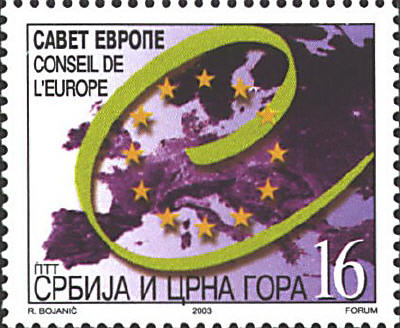|
Following World War II Yugoslavia brought
together six republics of different ethnic and religious backgrounds:
Serbia, Montenegro, Bosnia-Herzegovina, Croatia, Dalmatia, Slovenia.
In the 1990s the country was splintered by civil war. The Federal
Republic of Yugoslavia was renamed Serbia and Montenegro in 2003, with
a loose political union.
The first stamps of the new Republic, designed by
Radomir Bojancic and issued on April 3, 2003, commemorate the Council
of Europe. The design is a stylized "e" and a circle of twelve stars
reflecting the flag of the Council, with a map of Europe in the
background.
The name of the Republic, СРБИА И ЦРНА ГОРА, is
written in Cyrillic on the 16 dinar value, and represents the Serbian
alphabetic preference. On the 28.70 dinar value the same name is
written in the Latin characters preferred by the Montenegrins. In both
Serbia and Crna Gora (Montenegro, "Black Mountain") the official
language is Serbian, although 22% of the population of Montenegro
claim
Ijekavian Štokavian,
also a Serbian dialect, as their mother tongue. Croatian and Bosnian
are also spoken in Montenegro. The united Republic is predominantly
Orthodox Christian
In 2006 The Republic will hold a referendum on
independence.



|
